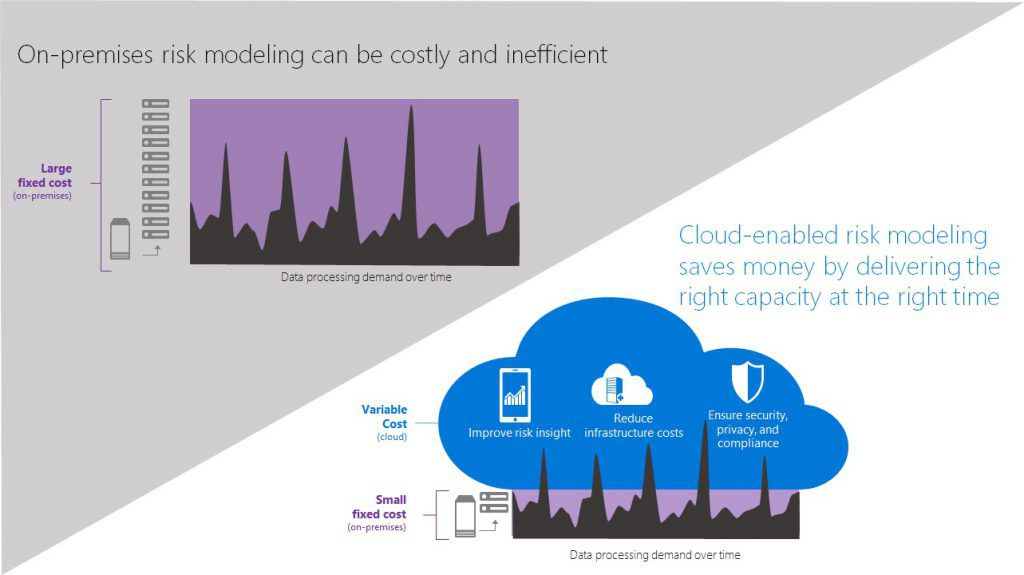
The Biggest Risk is the Status Quo
Risk modeling in the age of cloud
For an industry where risk prediction is the name of the game, many insurance providers are failing to recognize one of the biggest threats they face today: their own legacy systems. The cloud presents an opportunity for more powerful, secure, and efficient risk modeling, but insurers remain hesitant to move forward. This is understandable, as insurance providers tend to be more conservative when it comes to the adoption of new trends.
But cloud is far more than just a trendy buzzword. It is disrupting the insurance industry and driving innovation at a breakneck pace. The rest of the world is moving to the cloud – and insurance companies that don’t adopt early run the risk of falling behind. They are likely to end up with limited modeling capabilities, costly on-premises infrastructure expansions, and increased vulnerability to security breaches.

Limited computing capacity means limited modeling potential
For accurate risk modeling, speed and capacity are essential. Insurers are always pursuing solutions that will provide the computing power necessary to run models faster and which address a greater number of scenarios. However, most insurers currently lack the necessary resources. A 2014 study found that two thirds of insurers were still executing actuarial models on individual PCs and desktop apps. These tools lack the processing power needed for high-octane risk modeling.
Unprecedented amounts of data are becoming available to insurance companies, but that data is wasted without the capacity to turn it into insight. Low-capacity processers can’t handle the load from the raw data streams that contain granular customer insights. Instead, insurance agencies must resort to clunky demography and generalizations and limited analytics power decreases the accuracy of risk modeling. As a result, these firms are losing against more tech-savvy competitors that can offer precision pricing.
And greater accuracy in risk assessment isn’t just extra credit – it’s increasingly required of insurance agencies. New standards such as Solvency II, Dodd Frank and the International Financial Reporting Standards demand that insurers run more complex models more frequently. This is especially challenging for global insurance providers, who have many different regulatory demands to comply with. Most insurers can’t meet these demands with their current infrastructure, and expanding existing infrastructure is costly and time-consuming.
As the amount and variety of customer-specific data available to the insurance industry grows, their computing capacities need to keep pace. Cloud technology is a powerful replacement for legacy systems. Its massive capacity for data input gives insurance firms the scale and computational power needed to perform analyses quickly and simultaneously. Combined with machine learning technology that analyzes data with increasing intelligence, insurers are capable of more accurately assessing risk, customer churn, and fraud.
Expanding on-premises infrastructure is prohibitively expensive
To expand computing capacity enough to meet regulations and compete in the market, insurance companies that cling to on-premises technology will have to invest in millions of dollars of infrastructure enhancements which may quickly become obsolete. Furthermore, computing needs fluctuate – an insurer may normally use 2000 cores, but need 5000-10,000 for quarterly or annual risk models. The inflexibility of on-premises models means that firms are either sitting on unused capacity, or unable to meet unexpected spikes in demand.
Insurers need a solution that is both flexible and cost-effective. Cloud computing gives firms access to tremendous computing power as they need it. SaaS solutions with consumption-model pricing allow for flexibility, and total cost of ownership is significantly lower. Businesses can expect to save significantly on their IT costs just by moving their infrastructure to the cloud.
Legacy systems are more vulnerable to attack
It’s natural for insurance companies to be concerned about the risk of working in the cloud. But in most instances, companies find that the cloud provider has more stringent security standards and requirements than their own data center. Few individual organizations can replicate the technology safeguards and operational processes that technology providers like Microsoft have developed to protect enterprise cloud services and comply with a wide range of international standards.
MetLife
Forward-thinking insurance companies are acknowledging the risks inherent to legacy technology and taking steps to stay ahead of the curve. MetLife is one of these early adopters. Serving 100 million customers in almost 50 countries, MetLife is one of the largest life insurance companies in the world. MetLife created a processing environment called MetLife Integrated Actuarial Modeling Environment (MIAME), an end-to-end high-performance computing grid-based solution on Microsoft HPC Pack, Windows Server, Microsoft Analytics Platform System, and Microsoft SQL Server. To increase compute capacity, speed, and performance while reducing costs, MetLife shifted some of the heavy lifting of the high-performance computing and data processing required by MIAME to the Microsoft Azure cloud platform. That enables MetLife to take full advantage of the flexibility and scalability of its data processing capabilities to achieve faster, more accurate actuarial calculations and save significant infrastructure costs, resulting in more value for the customer and the company.
Because MetLife needed a platform that integrated well with their existing tools and processes, the Microsoft Azure cloud computing platform was its first choice. By taking advantage of Azure for processing the massive and complex financial calculations MetLife needs to perform each month, the company can achieve several goals. During peak times, MIAME can scale exponentially to meet business and regulatory needs, which enables faster delivery. By using the Microsoft cloud rather than continuing to build out its own calculation infrastructure, MetLife expects to save 45 to 55 percent in infrastructure costs that it might otherwise incur to meet reporting timeframes. This also creates year-over-year savings for the company.
Out-computing risk with the Microsoft cloud
Given the massive savings and precision potential that companies like MetLife have seen by adopting cloud computing, the technology is increasingly becoming a requirement rather than a choice for insurance companies. Microsoft Azure, a leading public cloud platform, offers superior risk modeling capacity. Azure delivers powerful analytics capabilities combined with a cloud-based environment that address the limitations of legacy systems and older ISV applications that require regular servicing. With unmatched scalability, flexible consumption-model pricing, and the availability of both hybrid and cloud environments, Azure enables customers to offload technology requirements to Microsoft, while maintaining control over their data. Microsoft’s partnerships with solution providers such as Willis Towers Watson, Milliman, FIS, and GGY are always growing, demonstrating the breadth of services that Azure can offer the insurance industry.
Microsoft has made significant investments to build out a platform with the security, privacy, compliance, and transparency required for the financial services industry. When companies use Azure, they benefit from Microsoft’s unmatched scale and experience running compliant online services around the globe. Azure meets a broad set of international and industry-specific compliance standards, such as FISC, IRS 1075, and PCI DSS Level 1. You can read more about our practices by visiting the Microsoft Azure Trust Center, which provides detailed security, privacy, and compliance information about our cloud services to help customers make their own regulatory assessments.
Insurance firms that are hesitant to embrace the cloud will find themselves falling behind in terms of risk modeling capacity, struggling to keep up with regulatory standards, and more vulnerable to security threats. The risks of sticking with outdated IT are matched only by the opportunities of cloud and machine learning. Learn more today about what Azure cloud computing and machine learning can offer insurance firms at www.microsoft.com/insurance.




